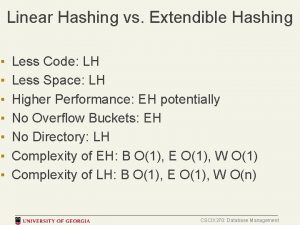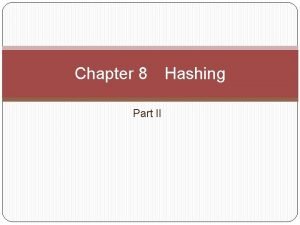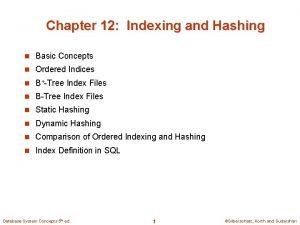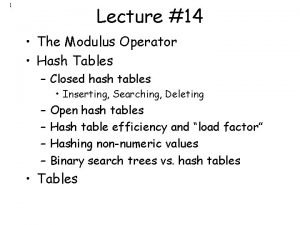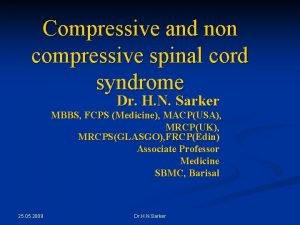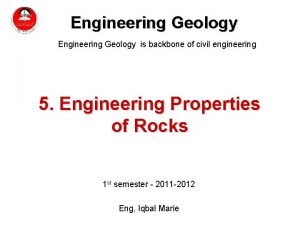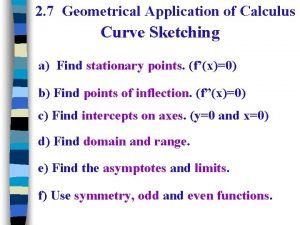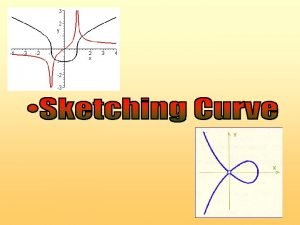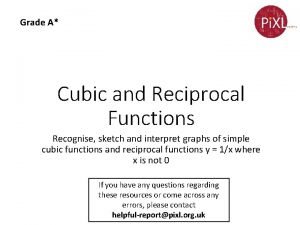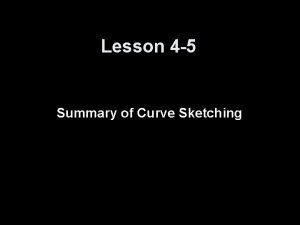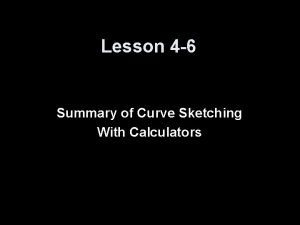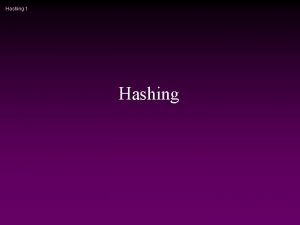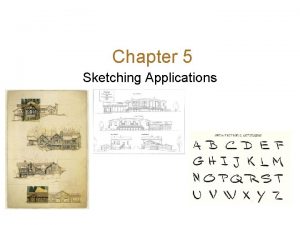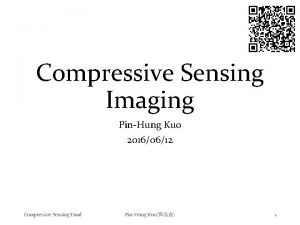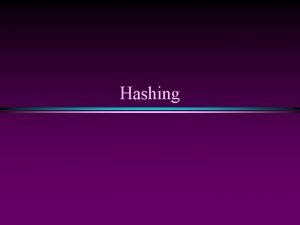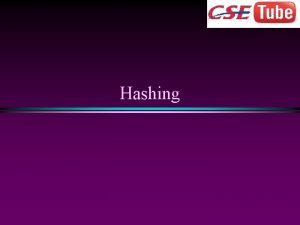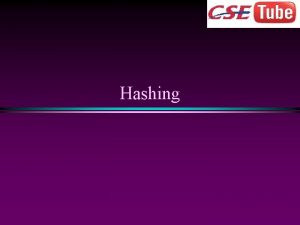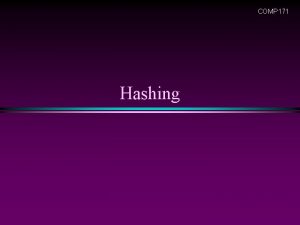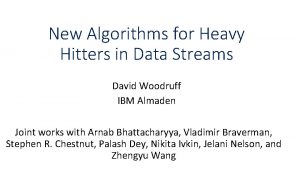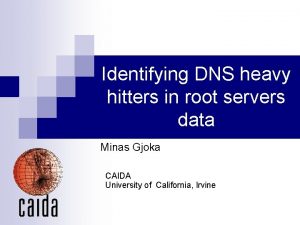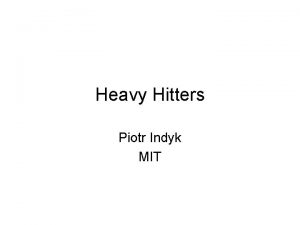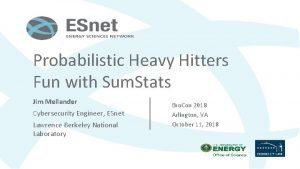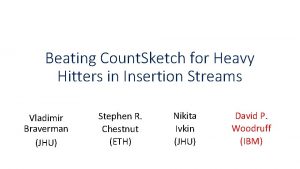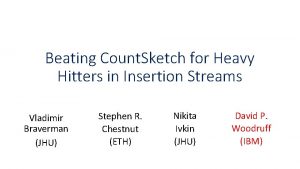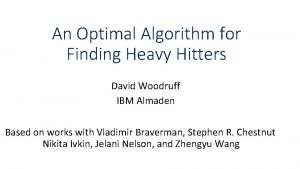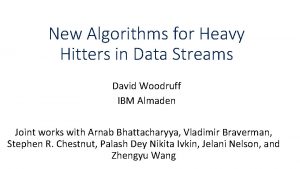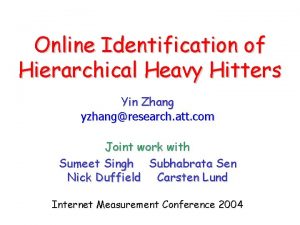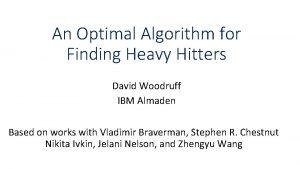Sketching via Hashing from Heavy Hitters to Compressive







![Compressive sensing [Candes-Romberg-Tao, Donoho] • (also: approximation theory, learning Fourier coeffs, finite rate of Compressive sensing [Candes-Romberg-Tao, Donoho] • (also: approximation theory, learning Fourier coeffs, finite rate of](https://slidetodoc.com/presentation_image_h/7ec58c93f2d6a6c4fb6eea58b2d4feb6/image-8.jpg)
![Applications • Single pixel camera [Wakin, Laska, Duarte, Baron, Sarvotham, Takhar, Kelly, Baraniuk’ 06] Applications • Single pixel camera [Wakin, Laska, Duarte, Baron, Sarvotham, Takhar, Kelly, Baraniuk’ 06]](https://slidetodoc.com/presentation_image_h/7ec58c93f2d6a6c4fb6eea58b2d4feb6/image-9.jpg)









![Fourier Transform • Discrete Fourier Transform: – Given: a signal x[1…n] – Goal: compute Fourier Transform • Discrete Fourier Transform: – Given: a signal x[1…n] – Goal: compute](https://slidetodoc.com/presentation_image_h/7ec58c93f2d6a6c4fb6eea58b2d4feb6/image-19.jpg)




![Filters: boxcar filter (used in[GGIMS 02, GMS 05]) • Boxcar -> Sinc – Polynomial Filters: boxcar filter (used in[GGIMS 02, GMS 05]) • Boxcar -> Sinc – Polynomial](https://slidetodoc.com/presentation_image_h/7ec58c93f2d6a6c4fb6eea58b2d4feb6/image-24.jpg)



- Slides: 27

Sketching via Hashing: from Heavy Hitters to Compressive Sensing to Sparse Fourier Transform Piotr Indyk MIT

Outline • Sketching via hashing c 1 … cm • Compressive sensing • Numerical linear algebra (regression, low rank approximation) b A • Sparse Fourier Transform

“Sketching via hashing”: a technique • Suppose that we have a sequence S of elements a 1. . as from range {1…n} • Want to approximately count the elements using small space a 1, a 2, a 3, a 4, …………as – For each element a, get an approximation of the count xa of a in S • Method: – Initialize an array c=[c 1, …cm] – Prepare a random hash function h: {1. . n}→{1. . m} – For each element a perform ch(a)=ch(a)+inc(a) • Result: cj=∑a: h(a)=j xa * inc(a) • To estimate xa return x*a = ch(a)/inc(a) a c 1 … ch(a) … cm

Why would this work? • We have ch(a) =xa*inc(a)+noise • Therefore x*a = ch(a)/inc(a) = xa+noise/inc(a) • Incrementing options: – inc(a)=1 [FCAB 98, EV’ 02, CM’ 03, CM’ 04] Simply counts the total, no underestimation – inc(a)=± 1 [CFC’ 02] Noise cancel, unbiased estimator, can under-estimate – inc(a)=Gaussian [GGIKMS’ 02] Noise has a nice distribution xa c 1 … ch(a) … cm cj=∑a: h(a)=j xa * inc(a) x*a = ch(a)/inc(a)

What are the guarantees? • For simplicity, consider inc(a)=1 • Tradeoff between accuracy and space m • Definitions: – Let k=m/C – Let H be the set of k heaviest coefficients of x , i. e. , the “head” – Let Tail 1 k=||x-H||1 (i. e. , the sum of coeffs not in the head) • Will show that, with constant probability xa ≤ x*a ≤xa + Tail 1 k/k • Meaning: – For a stream with s elements, the error is always at most 1/k * s – Even better if head really heavy Head xa xa * c 1 … cm cj=∑a: h(a)=j xa x*a = ch(a)

Analysis • We show to get an estimate Head xa x*a ≤xa + Tail / k • • Pr[ |x*a-xa| > Tail/k] ≤ P 1+P 2, where P 1 = Pr[ a collides with (another) head element ] P 2 = Pr[ sum of tail elems colliding with a is > Tail/k ] We have P 1 ≤ k/m =1/C P 2 ≤ (Tail/m)/(Tail/k) = k/m = 1/C • Total probability of failure ≤ 2/C • Can reduce the probability to 1/poly(n) by log n repetitions space O(k log n) xa * c 1 … cm cj=∑a: h(a)=j xa x*a = ch(a)

Compressive sensing
![Compressive sensing CandesRombergTao Donoho also approximation theory learning Fourier coeffs finite rate of Compressive sensing [Candes-Romberg-Tao, Donoho] • (also: approximation theory, learning Fourier coeffs, finite rate of](https://slidetodoc.com/presentation_image_h/7ec58c93f2d6a6c4fb6eea58b2d4feb6/image-8.jpg)
Compressive sensing [Candes-Romberg-Tao, Donoho] • (also: approximation theory, learning Fourier coeffs, finite rate of innovation, …) Setup: – Data/signal in n-dimensional space : x E. g. , x is an 256 x 256 image n=65536 – Goal: compress x into a “measurement” Ax , where A is a m x n “measurement matrix”, m << n • Requirements: – Plan A: want to recover x from Ax • Impossible: underdetermined system of equations – Plan B: want to recover an “approximation” x* of x • Sparsity parameter k • Informally: want to recover largest k coordinates of x • Formally: want x* such that e. g. (L 1/L 1) ||x*-x||1 C minx’ ||x’-x||1 =C Tail 1 k over all x’ that are k-sparse (at most k non-zero entries) • Want: – Good compression (small m=m(k, n)) – Efficient algorithms for encoding and recovery • Why linear compression ? A x = Ax
![Applications Single pixel camera Wakin Laska Duarte Baron Sarvotham Takhar Kelly Baraniuk 06 Applications • Single pixel camera [Wakin, Laska, Duarte, Baron, Sarvotham, Takhar, Kelly, Baraniuk’ 06]](https://slidetodoc.com/presentation_image_h/7ec58c93f2d6a6c4fb6eea58b2d4feb6/image-9.jpg)
Applications • Single pixel camera [Wakin, Laska, Duarte, Baron, Sarvotham, Takhar, Kelly, Baraniuk’ 06] • Pooling Experiments [Kainkaryam, Woolf’ 08], [Hassibi et al’ 07], [Dai-Sheikh, Milenkovic, Baraniuk], [Shental-Amir-Zuk’ 09], [Erlich-Shental-Amir. Zuk’ 09], [Kainkaryam, Bruex, Gilbert, Woolf’ 10]…

Scale: Excellent Very Good Fair Results Paper R/ D Sketch length Recovery time Approx [Candes-Romberg. Tao’ 04] D k log(n/k) nc l 2 / l 1

Sketching as compressive sensing • Hashing view: – h hashes coordinates into “buckets” c 1…cm – Each bucket sums up its coordinates xa • Matrix view: – A 0 -1 mxn matrix A, with one 1 per column – The a-th column has 1 at position h(a), where h(a) be chosen uniformly at random from {1…m} • Sketch is equal to c=Ax • Guarantee: if we repeat hashing log n times then with high probability ||x*-x||∞ Tail 1 k/k L∞ /L 1 guarantee, implies L 1/L 1 xa * c 1 … cm n 0 0 1 0 1 0 0 m 0 1 0 0 0

Scale: Excellent Very Good Fair Results Paper R/ D Sketch length Recovery time Approx [Candes-Romberg. Tao’ 04] D k log(n/k) nc l 2 / l 1 [CCF’ 02], [CM’ 06] R k log n n log n l 2 / l 2 [CM’ 04] R k log n n log n l 1 / l 1 ……. . [NV’ 07], [DM’ 08], [NT’ 08], [BD’ 08], [GK’ 09], … D k log(n/k) nk log(n/k) * log l 2 / l 1 D k logc n n log n * log l 2 / l 1 [IR’ 08], [BI’ 09] D k log(n/k) n log(n/k)* log l 1 / l 1 Insight: Several random hash functions form an expander graph xi xi * c 1 … cm

Regression

Least-Squares Regression • A is an n x d matrix, b an n x 1 column b vector – Consider over-constrained case, n >> d • Find d-dimensional x so that ||Ax-b||2 ≤ (1+ε) miny ||Ay-b||2 • Want to find the (approx) closest point in the column space of A to the vector b A

Approximation • Computing the solution exactly takes O(nd 2) time b • Too slow, so ε > 0 and a tiny probability of failure OK • Approach: sub-space embedding [Sarlos’ 06] – Consider subspace L spanned by columns of A together with b – Want: mxn matrix S, m “small”, such that for all y in L ||Sy||2 = (1± ε) ||y||2 – Then ||S(Ax-b)||2 = (1± ε) ||Ax-b||2 for all x – Solve argminy ||(SA)y – (Sb)||2 – Given SA, Sb, can solve in poly(m) time A Sb SA

Fast Dimensionality Reduction • Need mxn dimensionality reduction matrix S such that: – m is “close to” d, and – matrix-vector product Sz can be computed quickly • Johnson-Lindenstrauss: O(nm) time • Fast Johnson-Lindenstrauss: O(n log n) (randomized Hadamard transform) [AC’ 06, AL’ 11, KW, 11 , NPW’ 12] • Sparse Johnson-Lindenstrass: O(nnz(z)*εm) [SPD+09, WDL+09, DKS 10, BOR 10, KN 12] • Surprise! For subspace embedding O~(nnz(z)) time and m=poly(d) suffices [CW 13, NN 13, MM 13] • Leads to regression and low-rank approx algorithms with O~(nnz(A)+poly(d)) running time • Count-sketch-like matrix S: [ 0 0 1 0 0 0 0 0 -1 1 0 -1 0 0 0 0 0 1

Heavy hitters a la regression • Can assume columns of A are orthonormal – ||A||F 2 = d • Let T be any set of size O(d 2) containing all rows indexes i in [n] for which the row Ai has squared norm Ω(1/d) A – “Heavy hitter rows” • Suffices to ensure: – Heavy hitters do not collide – perfect hashing – Smaller elements concentrate • This gives sparse dimensionality reduction matrix with m=poly(d) rows – Clarkson-Woodruff: m=O~(d 2) – Nelson-Nguyen: m=O~(d) T

Sparse Fourier Transform
![Fourier Transform Discrete Fourier Transform Given a signal x1n Goal compute Fourier Transform • Discrete Fourier Transform: – Given: a signal x[1…n] – Goal: compute](https://slidetodoc.com/presentation_image_h/7ec58c93f2d6a6c4fb6eea58b2d4feb6/image-19.jpg)
Fourier Transform • Discrete Fourier Transform: – Given: a signal x[1…n] – Goal: compute the frequency vector x’ where x’f = Σt xt e-2πi tf/n • Very useful tool: – – Compression (audio, image, video) Data analysis Feature extraction … • See SIGMOD’ 04 tutorial “Indexing and Mining Streams” by C. Faloutsos Sampled Audio Data (Time) DFT of Audio Samples (Frequency)

Computing DFT • Fast Fourier Transform (FFT) computes the frequencies in time O(n log n) • But, we can do (much) better if we only care about small number k of “dominant frequencies” – E. g. , recover assume it is k-sparse (only k nonzero entries) • Algorithms: – Boolean cube (Hadamard Transform): [GL’ 89], [KM’ 93], [L’ 93] – Complex FT: [Mansour’ 92, GGIMS’ 02, AGS’ 03, GMS’ 05, Iwen’ 10, Akavia’ 10, HIKP’ 12 b, BCGLS’ 12, LWC’ 12, GHIKPL’ 13, …] • Best running times [Hassanieh-Indyk-Katabi. Price’ 12] – Exactly k-sparse signals: O(k log n) – Approx. k-sparse signals* : O(k log n * log(n/k)) *L 2/L 2 guarantee

Intuition: Fourier Time Domain Signal ‘ Frequency Domain Cut off Time signal ‘ Frequency Domain First B samples Frequency Domain ‘

Main task • We we would like this … to act like this:

Issues • “Leaky” buckets • “Hashing”: needs a random hashing of the spectrum • …
![Filters boxcar filter used inGGIMS 02 GMS 05 Boxcar Sinc Polynomial Filters: boxcar filter (used in[GGIMS 02, GMS 05]) • Boxcar -> Sinc – Polynomial](https://slidetodoc.com/presentation_image_h/7ec58c93f2d6a6c4fb6eea58b2d4feb6/image-24.jpg)
Filters: boxcar filter (used in[GGIMS 02, GMS 05]) • Boxcar -> Sinc – Polynomial decay – Leaking many buckets

Filters: Gaussian • Gaussian -> Gaussian – Exponential decay – Leaking to (log n)1/2 buckets


Conclusions • Sketching via hashing – Simple technique – Powerful implications c 1 … cm • Questions: – What is next ? b A
 Linear hashing
Linear hashing What is static hashing in dbms
What is static hashing in dbms Static hashing and dynamic hashing
Static hashing and dynamic hashing What does a modulo operator do
What does a modulo operator do Ratey rational functions
Ratey rational functions Normal concrete
Normal concrete Non compressive myelopathy
Non compressive myelopathy Which rock possesses very high compressive strength
Which rock possesses very high compressive strength Sexta estacion del via crucis
Sexta estacion del via crucis Palavras convergentes
Palavras convergentes Via negativa
Via negativa Via crusis
Via crusis Via piramidal y extrapiramidal
Via piramidal y extrapiramidal Sketching as a tool for numerical linear algebra
Sketching as a tool for numerical linear algebra Concept sketching engineering
Concept sketching engineering Multiview drawing
Multiview drawing Sketching graphs calculus
Sketching graphs calculus Missing view
Missing view Multiview drawing practice problems
Multiview drawing practice problems Cross projection method sketching
Cross projection method sketching Curve sketching examples with solutions doc
Curve sketching examples with solutions doc How to do slope fields
How to do slope fields How to sketch reciprocal functions
How to sketch reciprocal functions Rough sketch of crime scene
Rough sketch of crime scene Summary of curve sketching
Summary of curve sketching Curve sketching calculator
Curve sketching calculator Forensic crime scene sketch
Forensic crime scene sketch Multi-view drawing
Multi-view drawing
